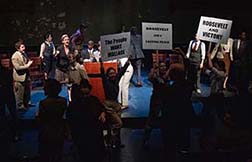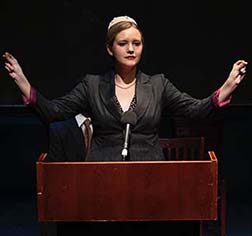
Lucy
Komisar
"Convention,” a terrific reprise of 1944 Dem convention that chose moderate Truman for VP instead of Wallace “Convention.” It is the 1944 Democratic Convention in Chicago that will nominate FDR for a fourth term.
But Roosevelt is dying, and the real convention fight is over the vice president who will be his successor. Henry Wallace (Claire Mikelle Anderson) has been in the post, but he is a left-winger. Truman is the moderate. And the Democrats in charge are corrupt. The delegates are noisy. Shouts are for Wallace. The Democratic National Committee chairman Robert Hannegan (Ashley Alvarrez) declares, “People are simple. They don’t understand how politics works….If Wallace becomes president, we are in deep trouble.” The DNC is plotting, which makes you realize that its manipulations haven’t changed. Read Sanders for Wallace. There’s a split in the labor movement. Sidney Hillman (Gabrielle Djenné) and Phillip Murray (Michael Pantozzi) are leaders of the Congress of Industrial Organization, Murray supports Wallace, but Hillman is urging Truman to run.
California is for Wallace, but the former governor (Greg Hudson) demurs. He is being bought off with the promise of an ambassadorship to Mexico. He argues that the problem is “people think Wallace is a communist. He wants to be friends with the Russians.” The drunken Senator Bennett Clark (Paul Corning) of Missouri accuses Wallace of visiting Latin America and speaking Spanish. The strongest voices for Wallace are two women, Senator Helen Gahagan Douglas (a superb Lizzie Stewart) and Secretary of Labor Frances Perkins (finely portrayed by Ginnie House). “There is nothing moderate about The New Deal,” Douglas says forcefully. “We can’t settle for moderates. There is only progress or regression.” “We need someone who’s on the right side of history,” declares Perkins, a passionate liberal. There is movement in the aisles, arguments in small groups. A reporter asks about Japanese internment. The action on all sides makes you feel part of the event.
The first roll call has Wallace with a plurality over Truman. Then the chair calls for an immediate re-vote, and Murray protests, “You keep changing the rules…” Now the California vote, which had gone for Wallace, is bought by Truman. Sue Kim is perfect as DNC secretary Dorothy Vrendenburgh overseeing the roll call in a deep southern accent. There are cameos by Mayor Edward Kelly of Chicago (McLean Peterson) and Senator Alben Barkley of Kentucky (Michael Leon), who would be Truman’s vice president. To make you feel that you really are at a convention, the theater is divided into five playing spaces. You may hear a few characters standing nearby in an aisle, while people across the audience hear others. All the conversations are scripted and timed so the director oversees them as if they were sounds in sheet music. In fact, instead of a sequential script, she uses a format called Score which has the lines of each of the 28 characters set horizontally. So, the author Danny Rocco and director Shannon Fillion are adventurous. I’ve never seen a production that makes you think it’s done in real time, with overlapping dialogue and voices. However, one adventure doesn’t work: gender-bending casting, with many of the male roles filled by women. And one woman played by a man. Maybe Glenda Jackson can do it for King Lear, but putting a tie on a woman and pulling her hair into a bun doesn’t make her believable as a man. Unlike Jackson, these actors don’t attempt male voices. The result is confusion and reduced credibility. Casting Daniel John Serpati as a drag Bess Truman is beyond ridiculous. Having a black man, Charles Everett, play Truman is distracting, especially as there are no other black people in the ensemble, which could have made a case for color blind casting. It probably approximates the real conditions of a July convention at the Chicago Stadium 75 years ago, but the theater, in a church, has no air conditioning. The audience gets fans. Think of it as you were there! If this were put on in schools and communities around the country, as it should be, they could be there, too! Visit Lucy’s website http://thekomisarscoop.com/ |
| recordings | coupons | publications | classified |



